Investigating Daylight in the Apartment Buildings in Melbourne, Australia
Abstract
:1. Introduction
2. Current State
3. Methodology
4. Results
4.1. Description of the Apartments
4.2. Daylight Measurements
4.3. Daylight Simulations
5. Discussion
6. Conclusions
Author Contributions
Funding
Conflicts of Interest
References
- Stevens, R.G.; Blask, D.E.; Brainard, G.C.; Hansen, J.; Lockley, S.W.; Provencio, I.; Rea, M.S.; Reinlib, L. Meeting Report: The Role of Environmental Lighting and Circadian Disruption in Cancer and Other Diseases. Environ. Health Perspect. 2007, 115, 1357–1362. [Google Scholar] [CrossRef] [PubMed] [Green Version]
- Czeisler, C.A.; Gooley, J.J. Sleep and circadian rhythms in humans. Cold Spring Harbor Symposia Quant. Biol. 2007, 72, 579–597. [Google Scholar] [CrossRef] [PubMed] [Green Version]
- Figueiro, M.G.; Kalsher, M.; Steverson, B.C.; Heerwagen, J.; Kampschroer, K.; Rea, M.S. Circadian-effective Light and Its Impact on Alertness in Office Workers. Lighting Res. 2018, 51, 171–183. [Google Scholar] [CrossRef]
- Reinhart, C.F.; Jan, W. The Daylighting Dashboard—A Simulation-based Design Analysis for Daylit Spaces. Build. Environ. 2011, 46, 386–396. [Google Scholar] [CrossRef]
- Boubekri, M.; Lee, J. A comparison of four daylighting metrics in assessing the daylighting performance of three shading systems. J. Green Build. 2017, 12, 39–53. [Google Scholar] [CrossRef]
- Dogan, T.; Ye Chan Park, Y.C. A New Framework for Residential Daylight Performance Evaluation. In Proceedings of the 15th IBPSA Conference, San Francisco, CA, USA, 7–9 August 2017. [Google Scholar]
- Aries, M.B.C.; Aarts, M.P.J.; Van Hoof, J. Daylight and Health: A Review of the Evidence and Consequences for the Built Environment. Lighting Res. Technol. 2013, 47, 6–27. [Google Scholar] [CrossRef]
- Grimaldi, S.; Partonen, T.; Saarni, S.I.; Aromaa, A.; Lönnqvist, J. Indoors Illumination and Seasonal Changes in Mood and Behavior Are Associated with the Health-Related Quality of Life. Health Qual. Life Outcomes 2008, 6, 56. [Google Scholar] [CrossRef] [PubMed]
- Brown, M.J.; Jacobs, D.E. Residential Light and Risk for Depression and Falls: Results from the LARES Study of Eight European Cities. Public Health Rep. 1974, 126, 131–140. [Google Scholar] [CrossRef] [PubMed] [Green Version]
- Andersen, M.; Gochenour, S.J.; Lockley, S.W. Modelling ‘non-visual’ Effects of Daylighting in a Residential Environment. Build. Environ. 2013, 70, 138–149. [Google Scholar] [CrossRef] [Green Version]
- Cheung, H.D.; Chung, T.M. A Study on Subjective Preference to Daylit Residential Indoor Environment Using Conjoint Analysis. Build. Environ. 2008, 43, 2101–2111. [Google Scholar] [CrossRef]
- Xue, P.; Mak, C.M.; Cheung, H.D. The Effects of Daylighting and Human Behavior on Luminous Comfort in Residential Buildings: A Questionnaire Survey. Build. Environ. 2014, 81, 51–59. [Google Scholar] [CrossRef]
- Xue, P.; Mak, C.M.; Huang, Y. Quantification of Luminous Comfort with Dynamic Daylight Metrics in Residential Buildings. Energy Build. 2016, 117, 99–108. [Google Scholar] [CrossRef]
- Acosta, I.; Campano, M.Á.; Molina, J.F. Window Design in Architecture: Analysis of Energy Savings for Lighting and Visual Comfort in Residential Spaces. Appl. Energy 2016, 168, 493–506. [Google Scholar] [CrossRef]
- IWBI International WELL Building Institute. 2020, WELL V2 Pilot, Light Exposure and Education. Available online: https://v2.wellcertified.com/v/en/light/feature/1 (accessed on 10 August 2020).
- Truong, W.; Zandi, B.; Trinh, V.Q.; Khanh, T.Q. Circadian Metric–Computation of Circadian Stimulus Using Illuminance, Correlated Colour Temperature and Colour Rendering Index. Build. Environ. 2020, 184, 107146. [Google Scholar] [CrossRef]
- Mangkuto, R.A.; Rohmah, M.; Asri, A.D. Design optimisation for window size, orientation, and wall reflectance with regard to various daylight metrics and lighting energy demand: A case study of buildings in the tropics. Appl. Energy 2016, 164, 211–219. [Google Scholar] [CrossRef]
- Konis, K A Novel Circadian Daylight Metric for Building Design and Evaluation. Build. Environ. 2017, 113, 22–38. [CrossRef]
- Shoory, M. The Growth of Apartment Construction in Australia, Reserve Bank of Australia Bulletin June Quarter. 2016. Available online: https://www.rba.gov.au/publications/bulletin/2016/jun/pdf/bu-0616-3.pdf (accessed on 5 September 2019).
- Hodyl, L. 2014, To investigate planning policies that deliver positive social outcomes in hyper-dense, high-rise residential environments, The Winston Churchill Memorial Trust Australia, Churchill Trust, Australia. Available online: https://www.churchilltrust.com.au/project/?id=PR0014010 (accessed on 10 September 2019).
- Horne, R.; Nethercote, M. 2015, ‘Life in a Windowless Box: The Vertical Slums of Melbourne’ The Fifth State, 18 May, viewed 17 August. Available online: https://www.thefifthestate.com.au/innovation/design/life-in-awindowless-box-the-vertical-slums-of-melbourne/74004/ (accessed on 5 September 2019).
- Wynne, R. 2015, ‘The Planning Minister Richard Wynne on Better Apartments’, Urban, 3 June, viewed 14 August 2019. Available online: https://www.urban.com.au/news/the-planning-minister-richard-wynne-on-betterapartments (accessed on 5 September 2019).
- Victoria State Government. 2017, Apartment Design Guidelines for Victoria, Australia. Available online: https://www.planning.vic.gov.au/__data/assets/pdf_file/0030/80994/Apartment-Design-Guidelines-for-Victoria_August-2017.pdf (accessed on 10 August 2019).
- Australian Building Codes Board. (2011) Building Code of Australia: National Construction Code 2019 Volume 1. Available online: https://ncc.abcb.gov.au/20/05/19 (accessed on 1 September 2019).
- Australian/New Zealand Standard™. Interior and Workplace Lighting–General Principles and Recommendations; Standards Australia: Sydney, Australia; Standards New Zealand: Wellington, New Zealand, 2006; AS/NZS 1680.1:2006. [Google Scholar]
- The Illuminating Engineering Society of North America (IES). IESNA 2013, LM-83-12: Approved Method: IES Spatial Daylighting Autonomy (sDA) and Annual Sunlight Exposure (ASE). Available online: http://www.ies.org/store/product/approved-method-ies-spatial-daylight-autonomysda-and-annual-sunlight-exposure-ase-1287.cfm (accessed on 20 October 2019).
- BESS, Built Environment Sustainability Scorecard. 2020, Muncipal Authority of Victoria. Available online: https://bess.net.au/ (accessed on 5 August 2020).
- BS EN 17037:2018. Daylight in Buildings; British Standards Institution: London, UK, 2008. [Google Scholar]
- U.S. Green Building Council. LEED v4 for Homes Design and Construction; USGBC: Washington, DC, USA, 2019. [Google Scholar]
- Green Building Council of Australia. (2020) GreenStar Design & As-Built v1.2 Submission Guidelines. Available online: https://new.gbca.org.au/rate/rating-system/design-and-built/ (accessed on 10 August 2020).
- Australian Building Codes Board. (2019) Building Code of Australia: National Construction Code 2019 Volume 2. Available online: https://ncc.abcb.gov.au/20/05/19 (accessed on 5 September 2019).
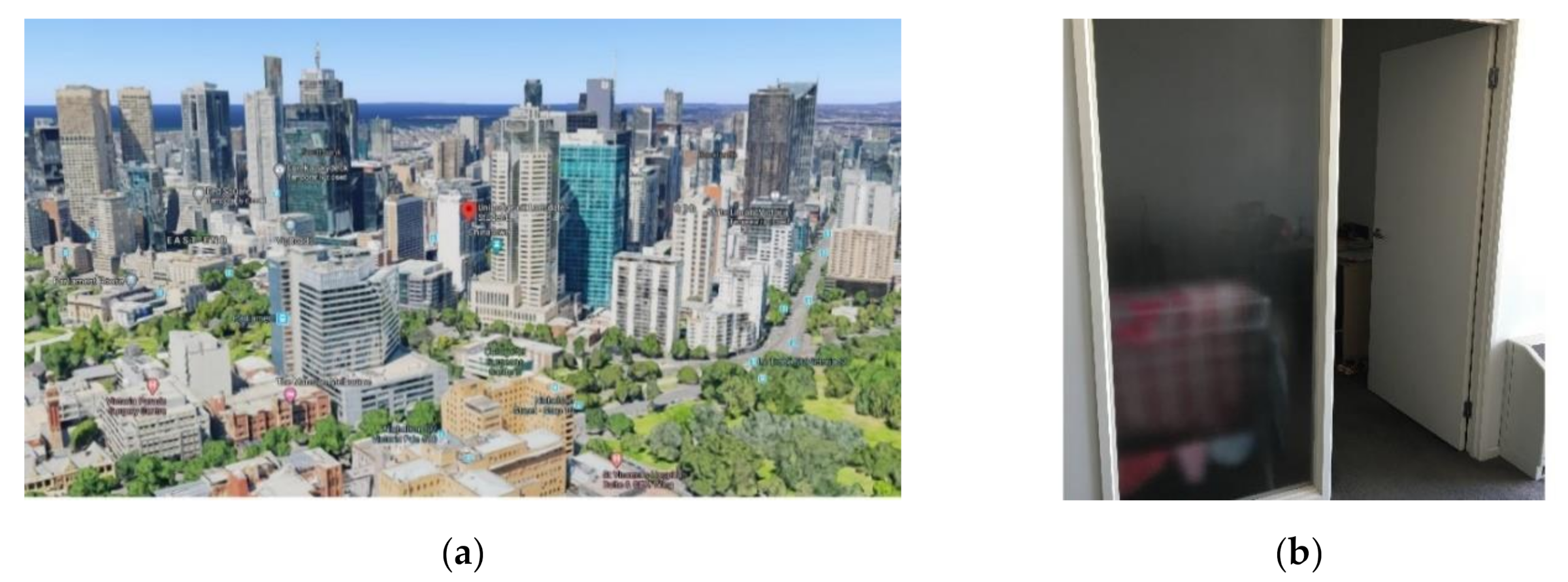
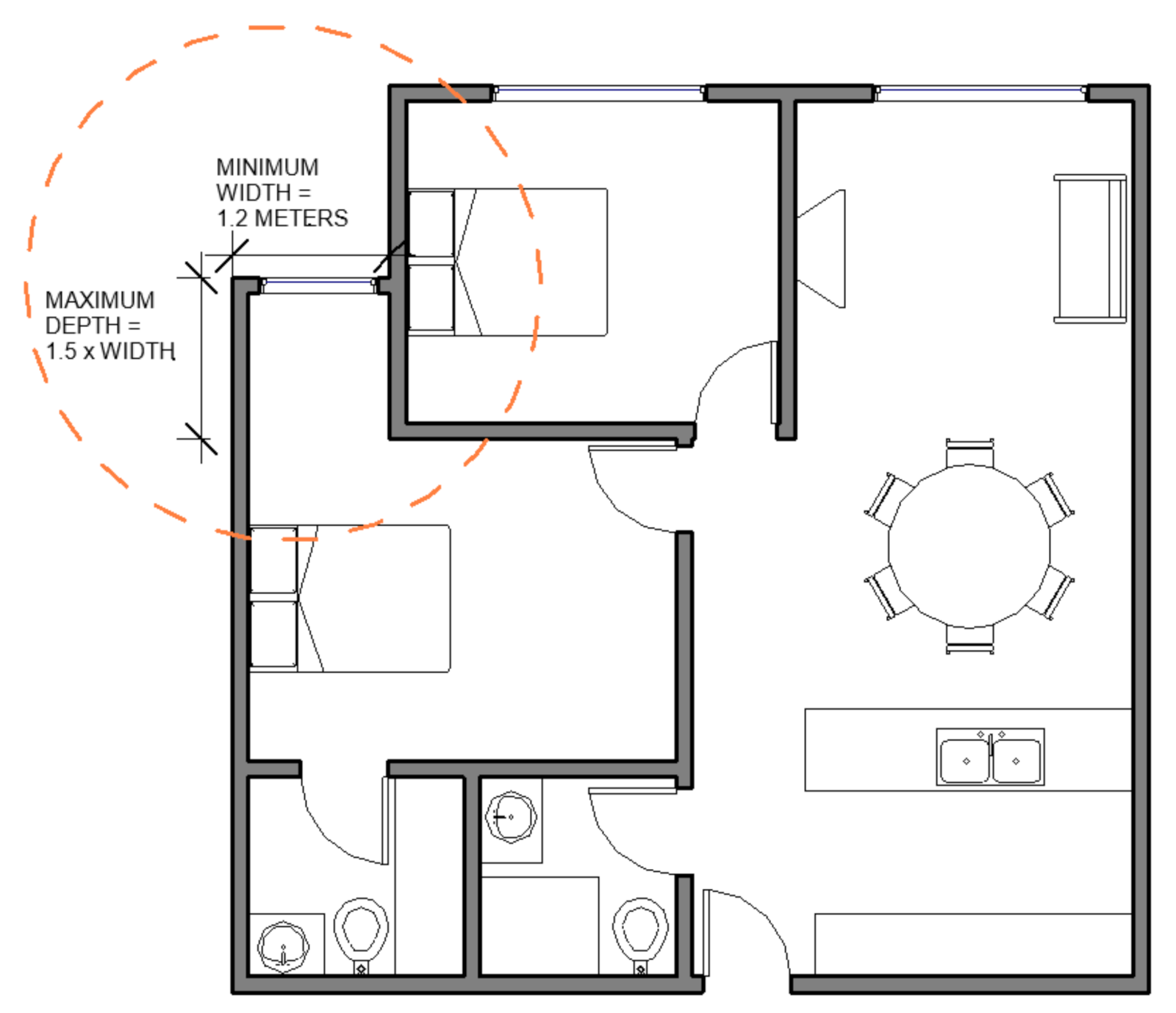
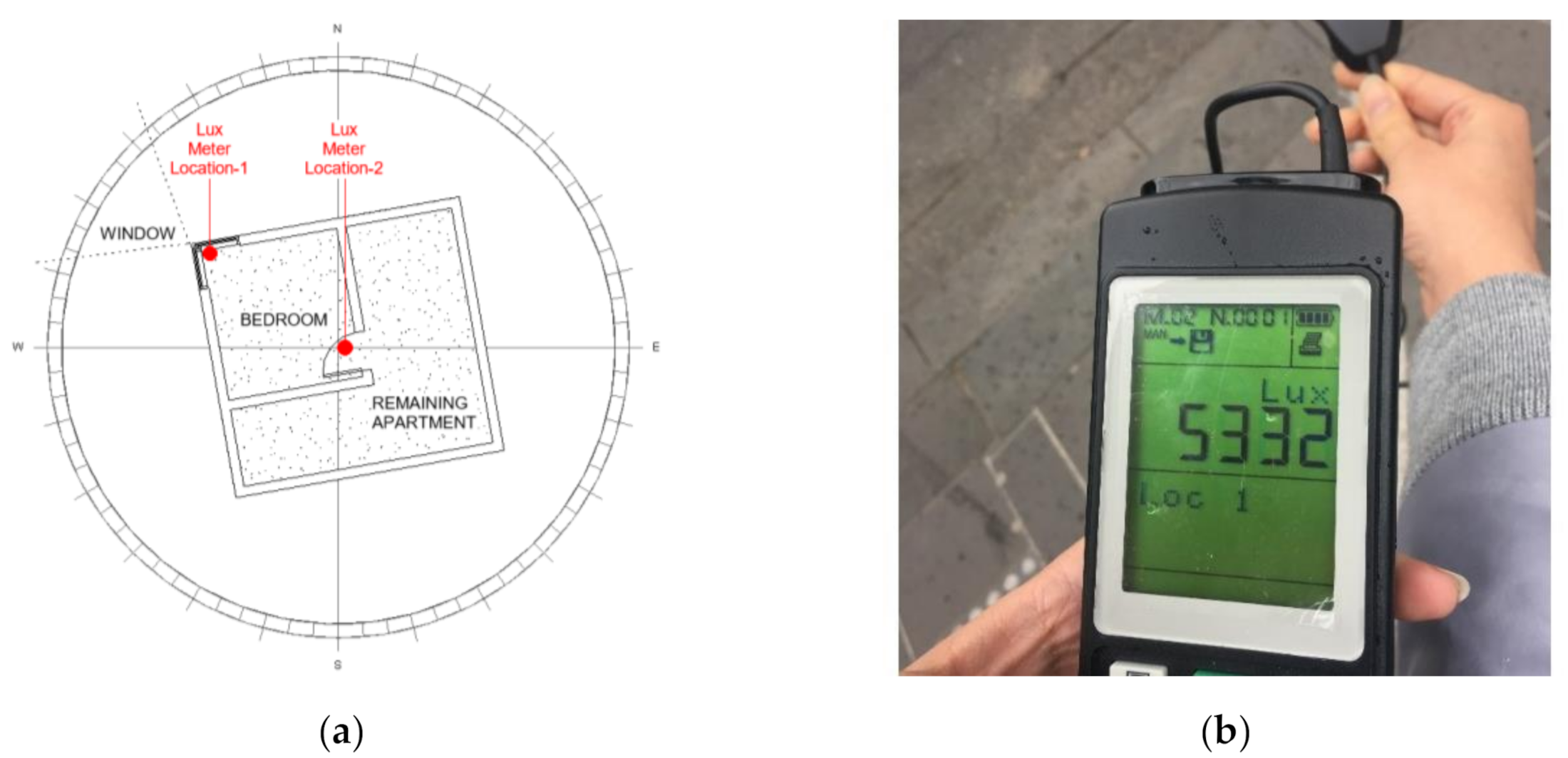
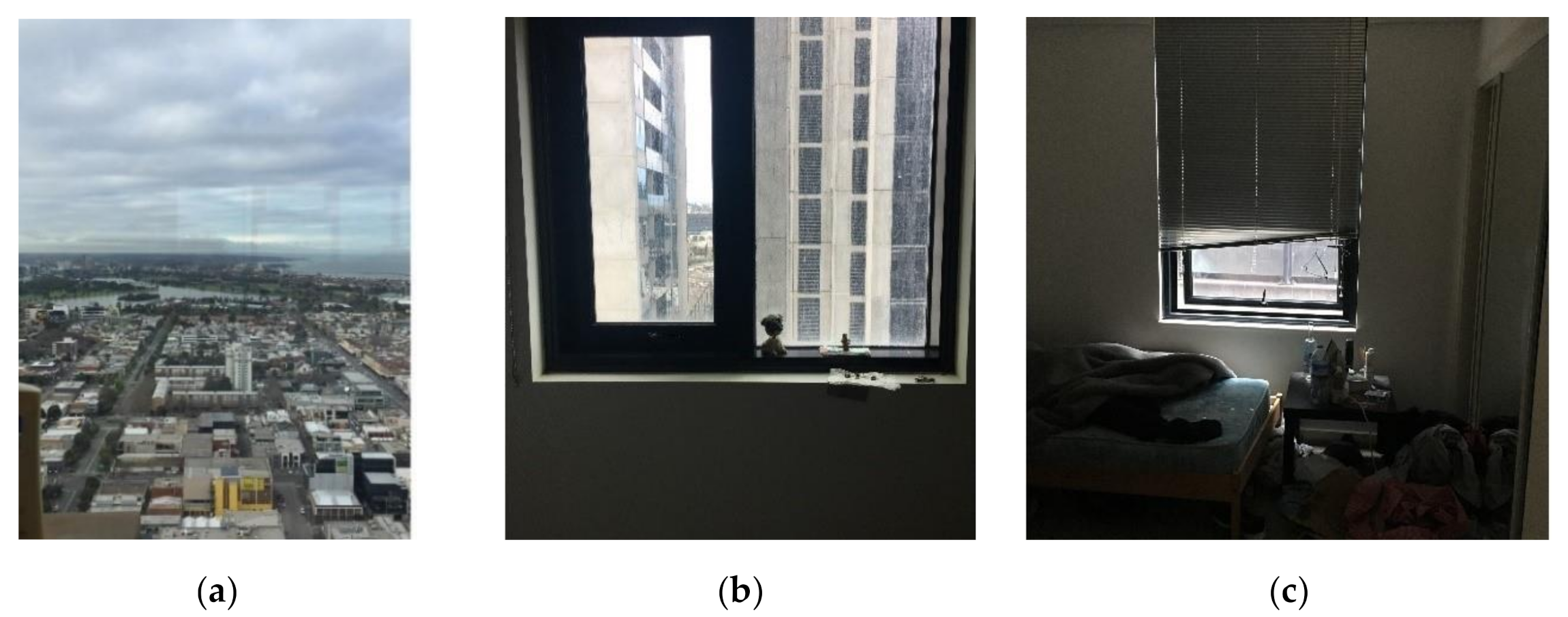

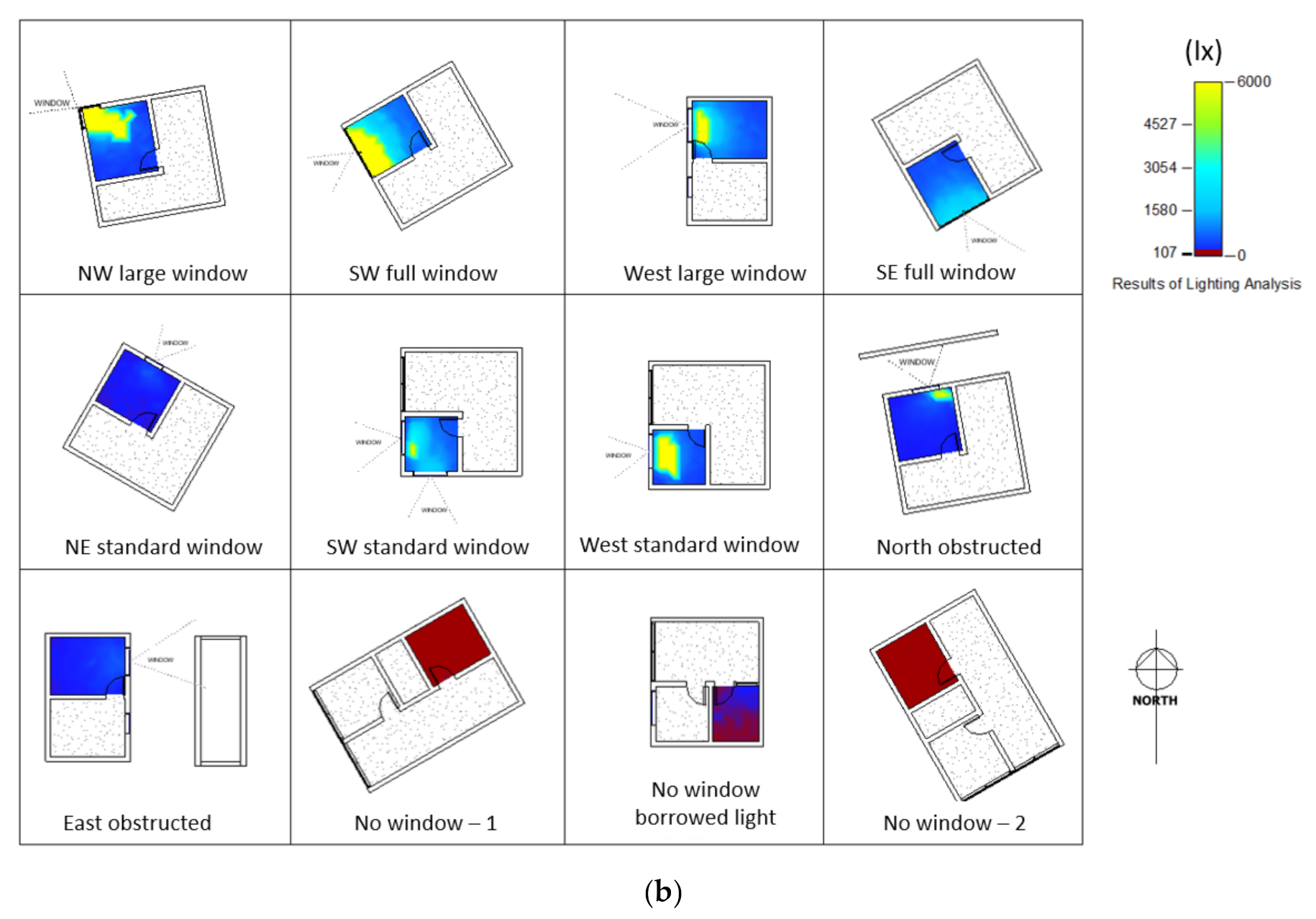
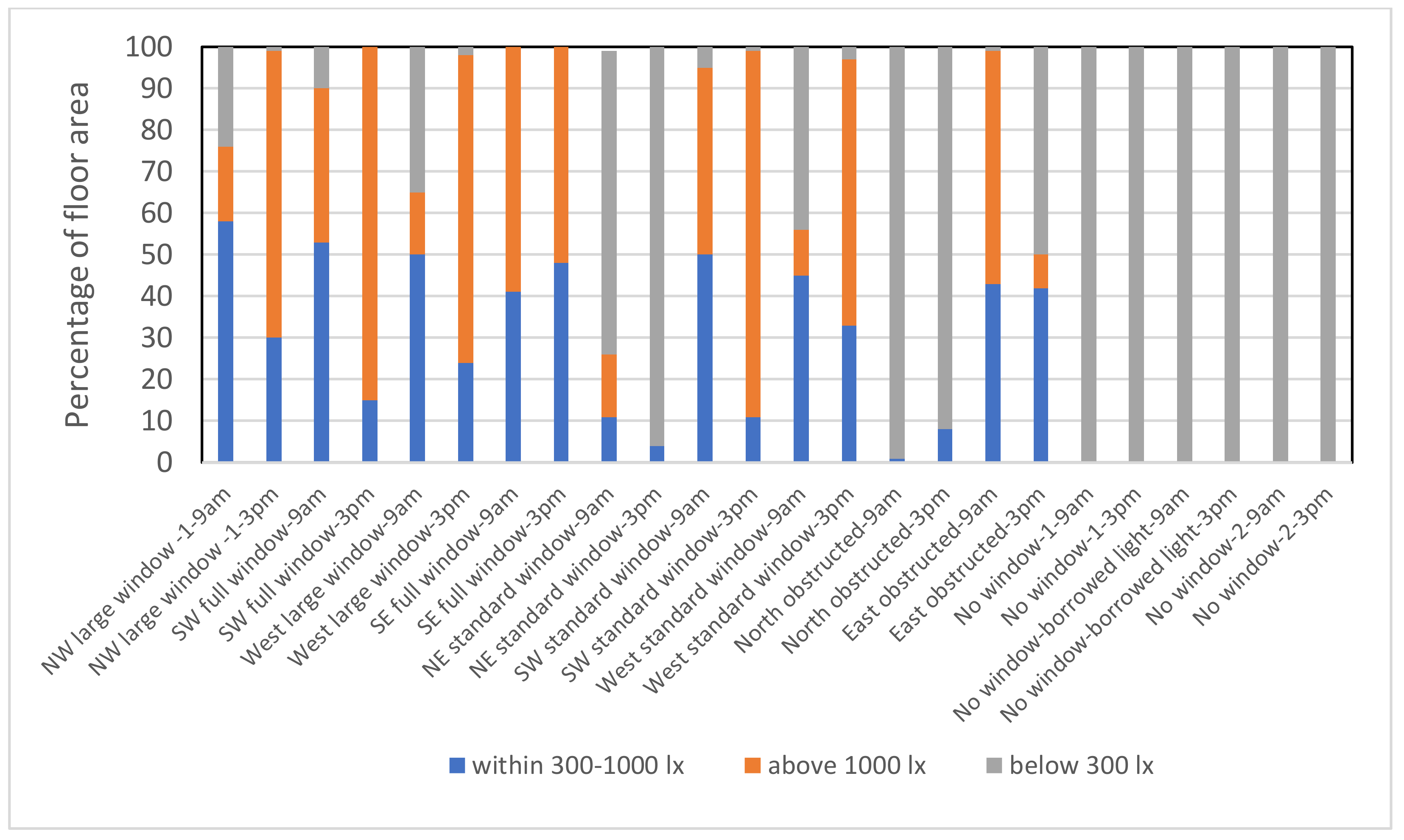
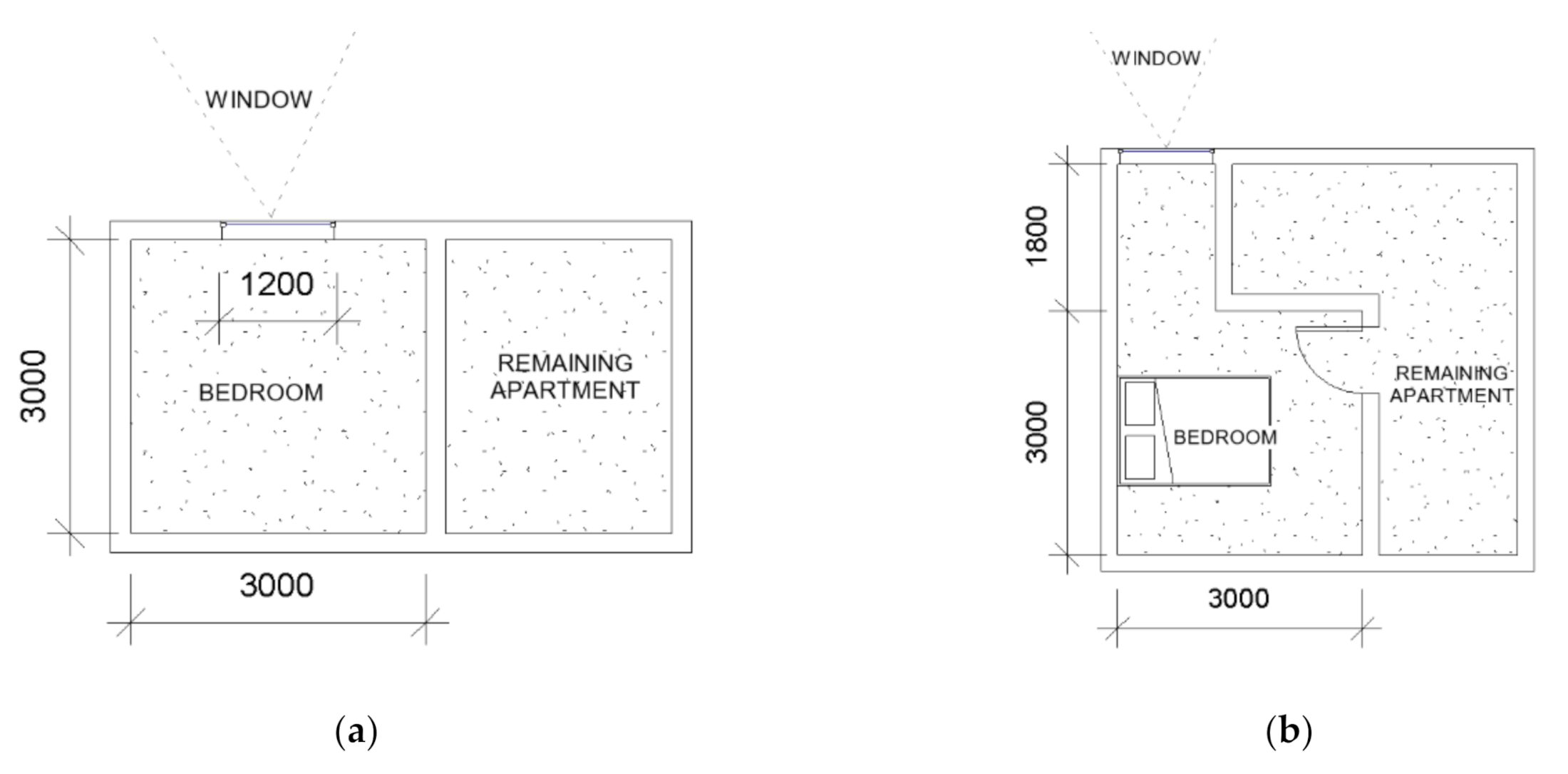

| Case No. | Name | Year of Construction | Floor Level | Bedroom Size (m2) | Window Size (m2) | Window Orientation | Window to Floor Ratio (%) | Views |
|---|---|---|---|---|---|---|---|---|
| 1 | NW large window | 2007 | 22 | 9 | 6 | North-West | 66 | 1 |
| 2 | SW full window | 2016 | 37 | 7 | 7 | South-West | 100 | 1 |
| 3 | West large window | 2009 | 1 | 8 | 3 | West | 37.5 | 1 |
| 4 | SE full window | 2016 | 13 | 7 | 7 | South-East | 100 | 1 |
| 5 | NE standard window | 2016 | 25 | 7 | 2 | North-East | 30 | 2 |
| 6 | SW standard window | 2004 | 12 | 6 | 3.8 | South-West | 62.5 | 2 |
| 7 | West standard window | 2003 | 11 | 6 | 2 | West | 33 | 2 |
| 8 | North obstructed | 2007 | 11 | 8 | 2 | North | 30 | 3 |
| 9 | East obstructed | 2009 | 1 | 8 | 2 | East | 27 | 3 |
| 10 | No window-1 | 2016 | 37 | 7 | 0 | No Window | 0 | 4 |
| 11 | No window-borrowed light | 2003 | 11 | 4.5 | 2 | Borrowed | 44 | 4 |
| 12 | No window-2 | 2016 | 25 | 7 | 0 | No Window | 0 | 4 |
| Case Name | Internal Illuminance (lx) | EML | External Illuminance (lx) | Ratio of Internal to External Illuminance | |||
|---|---|---|---|---|---|---|---|
| Next to Window | Away from Window | Next to Window | Away from Window | Next to Window | Away from Window | ||
| NW large window | 2093 | 78 | 2302 | 86 | 5332 | 39.5 | 1.5 |
| SW full window | 6613 | 602 | 7274 | 662 | 31,644 | 21 | 2 |
| West large window | 1637 | 320 | 1801 | 352 | 45,000 | 3.5 | 0.7 |
| SE full window | 1258 | 94 | 1384 | 103 | 6753 | 18.5 | 1.4 |
| NE standard window | 2203 | 79 | 2423 | 87 | 31,644 | 7 | 0.3 |
| SW standard window | 1731 | 993 | 1904 | 1092 | 5122 | 4 | 0.6 |
| West standard window | 1639 | 341 | 1803 | 375 | 45,000 | 3.5 | 0.75 |
| North obstructed | 375 | 5 | 413 | 6 | 6728 | 5.5 | 0.07 |
| East obstructed | 1459 | 94 | 1605 | 103 | 45,000 | 3 | 0.2 |
| No window-1 | 3 | 3 | 3 | 3 | 5122 | 0.05 | 0.05 |
| No window-borrowed light | 85 | 12 | 94 | 13 | 45,000 | 0.2 | 0.02 |
| No window-2 | 5 | 5 | 6 | 6 | 6728 | 0.07 | 0.07 |
| Case Names | sDA300/50 (%) | ASE 1000/250 (%) | LEED Points | WELL Points |
|---|---|---|---|---|
| NW large window | 84 | 44 | 0 | 2 |
| SW full window | 100 | 45 | 0 | 2 |
| West large window | 96 | 58 | 0 | 2 |
| SE full window | 95 | 0 | 3 | 2 |
| NE standard window | 55 | 25 | 0 | 1 |
| SW standard window | 94 | 62 | 0 | 2 |
| West standard window | 56 | 62 | 0 | 1 |
| North obstructed | 10 | 10 | 0 | 0 |
| East obstructed | 71 | 12 | 2 | 1 |
| No window-1 | 15 | 5 | 0 | 0 |
| No window-borrowed light | 0 | 0 | 0 | 0 |
| No window-2 | 15 | 10 | 0 | 0 |
© 2020 by the authors. Licensee MDPI, Basel, Switzerland. This article is an open access article distributed under the terms and conditions of the Creative Commons Attribution (CC BY) license (http://creativecommons.org/licenses/by/4.0/).
Share and Cite
Abidi, S.; Rajagopalan, P. Investigating Daylight in the Apartment Buildings in Melbourne, Australia. Infrastructures 2020, 5, 81. https://0-doi-org.brum.beds.ac.uk/10.3390/infrastructures5100081
Abidi S, Rajagopalan P. Investigating Daylight in the Apartment Buildings in Melbourne, Australia. Infrastructures. 2020; 5(10):81. https://0-doi-org.brum.beds.ac.uk/10.3390/infrastructures5100081
Chicago/Turabian StyleAbidi, Sehar, and Priyadarsini Rajagopalan. 2020. "Investigating Daylight in the Apartment Buildings in Melbourne, Australia" Infrastructures 5, no. 10: 81. https://0-doi-org.brum.beds.ac.uk/10.3390/infrastructures5100081




